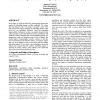Free Online Productivity Tools
i2Speak
i2Symbol
i2OCR
iTex2Img
iWeb2Print
iWeb2Shot
i2Type
iPdf2Split
iPdf2Merge
i2Bopomofo
i2Arabic
i2Style
i2Image
i2PDF
iLatex2Rtf
Sci2ools
MMSEC
2006
ACM
2006
ACM
Minimizing the embedding impact in steganography
In this paper, we study the trade-off in steganography between the number of embedding changes and their amplitude. We assume that each element of the cover image is assigned a scalar value that measures the impact of making an embedding change at that pixel (e.g., the embedding distortion). Given the embedding impact profile of all pixels, we derive an analytic formula for the optimal number of pixels that should be used in combination with syndrome coding to minimize the overall embedding impact. We interpret the results and formulate several “rules of thumb” that should improve steganographic security. Contrary to what has been recommended in the literature before, our analysis implies that it is never optimal to only use the pixels with the smallest embedding impact. We also study q-ary embedding in the spatial domain and conclude that the smallest embedding impact is achieved for ternary schemes. This confirms some empirically derived facts previously published elsewhere. Cat...
| Added | 14 Jun 2010 |
| Updated | 14 Jun 2010 |
| Type | Conference |
| Year | 2006 |
| Where | MMSEC |
| Authors | Jessica J. Fridrich |
Comments (0)

